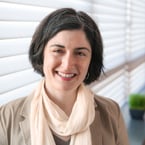My novel Discovered, in The Messengers series, has been out for a few weeks now, and I have loved hearing feedback from people with all kinds of backgrounds. One theme that I often hear is this: “How do I share this book?” The context might be a book club, a youth group, a classroom, or social media. This question excites my former-teacher self, and I start thinking of ways for me to help you get the word out about The Messengers and the message it contains.
So I’ll be trying to share different ideas that you may want to use or adapt in your own setting, and I’ll be offering them through a series of blog posts.
The first post? Well, I come from an English teacher background, so I’ll start with that: How to teach Discovered in a literature classroom.
Getting started . . . at the end. Did you know that there are questions at the end of the novel? There are two questions per chapter. Taken as a whole, they engage students in different ways over a variety of topics. If you’re teaching middle school and only assigning a chapter or two each night, this can be a great way to assess completion and comprehension. If you’re teaching high school students with longer reading loads, you may want to offer a choice of questions (pick X out of X) as a supplement to study. If you organize this unit as an in-class book club, these choices could then become discussion starters within small groups.
Digging deep . . . points to ponder. Are you looking for in-class discussion questions? lecture ideas? project-based learning themes? essay questions? I’ll list a few ideas to get started—questions I’d likely ask in a classroom—but you can take these and run with them to suit your objectives. These are currently written to avoid spoilers, but you can clarify more if you use these questions at the end of the unit. If you’d like my thoughts on answers, feel free to ask!
- Deus ex machina, “the god-machine,” is a literary technique that is sometimes used to rescue a character in a seemingly impossible situation. What examples of this do you find in the novel? This technique is sometimes criticized when used as an easy way to get out of a plot problem. How might it work here, considering the themes of the book? Was it used effectively in the examples you provided? Explain.
- Every five chapters, a separate narrative is included in the plot. Relate the plot of these narratives to the plot of the book. What connections can be made between the main character of the narratives and Simon, the main character of the book? Look also to ways Simon later engages with this narrative—in a more direct way. What lessons do both Simon and this other narrator learn?
- Study the narrative point of view of this book. How is it like other books? How is the perspective of this book different from many? Specifically talk about the way Simon sees his reality and how the reader learns about reality through him. How does this affect Simon’s (and the reader’s) discovery along the way?
- Dystopian literature is a popular genre. The Giver, Fahrenheit 451, 1984, and The Hunger Games are just a few examples. Research what it means for literature to be dystopian. In your opinion, why is this genre successful? How does this book follow these patterns? How does it deviate? (Teachers, check out this blog post if you want more information along these lines.)
Create interest. There are other ways to engage students than simply asking questions, of course. Here are a few other ideas.
- As a unit opener, create a dramatic anticipatory set. Let your kids walk into a dystopian classroom. You can use chapter 1 of Discovered for ideas to replicate Simon’s class, or you can create an entire world within your learning space. Make everything starkly plain—or give it an air of destruction. Begin your introduction with stern rules about classroom movement and the like. You may not want the mood to last long, but giving students a taste of Simon’s world may help them dig in with more ease.
- Decades ago, dystopian themes were popular on television. The Twilight Zone, for example, has many episodes that can be used at the beginning or in the middle of the unit. “The Obsolete Man” is one that particularly resonates with themes of Discovered. Use these for added discussion.
- To keep the audiovisual idea going a bit longer, also show students the Discovered book trailer either at the beginning of the unit or as an introduction to a project. After showing the trailer and perhaps a few videos as described above, challenge students to make their own book trailer for Discovered, or a book trailer for a dystopian novel they imagine themselves.
- In writing this book, I took one of my old classroom activities to extremes: writing to music. Almost every word was written with instrumental music in the background to help the mood. Have students spend some time with creative writing while you play three or four different pieces—all with very different moods. Let students write a few sketches, allowing the setting (and maybe even plot) to reflect the music played. If students show interest, this could be a larger project later, as student write at home to an entire soundtrack, for example.
Let me tell you, I had a blast thinking up ways to teach literature students this book! I hope these ideas help you. And we all know that a community of teachers can take an idea and turn it into something amazing. So please leave your ideas in the comments below! Or if you try something, let us know how you adapted it.
Also know that I’d love to engage with you and your students, so contact me if you’re interested.















